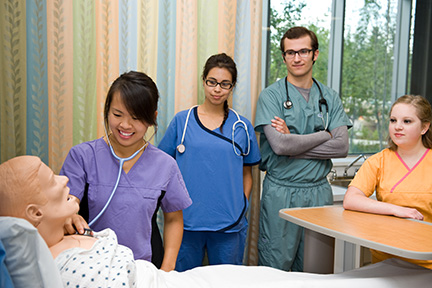Laboratory Experiences
The goal of laboratory experiences (labs) is to become practiced and confident in nursing psychomotor skills (skills that require varying levels of well-coordinated physical activity and precise procedures), in order to provide the basis for safe, effective care to patients and families in the clinical setting.
The Nursing Simulation Centre (the lab) is located on the ground floor of the Edmonton Clinic Health Academy.
Lab learning experiences are scheduled as a component of Nursing courses, and preparation prior to the lab session is expected (assigned readings, assignments, viewing audiovisual resources).
These are some of the skills that Faculty of Nursing students learn as part of the lab learning experiences over the course of their nursing program:
- Safety, standard precautions, and isolation procedures
- WHMIS and emergency procedures
- Documentation of patient care
- Medication safety, calculation, and administration
- Health history and health assessment techniques
- Individual and family communication, client education, professional boundaries
- Community assessment
- Mental status assessment
- Management of care for people with mental health challenges
- Vital sign assessment (temperature, pulse, respiration, blood pressure)
- Cardiovascular and peripheral vascular assessment
- Musculoskeletal and nervous system assessment
- Urethral catheterization
- Intravenous (IV) initiation and therapy
- Blood administration
- Complex wound management
- Diabetic care
- Parenteral medications
- Assessment and management of the acute care client
- Pre- and post-operative care
- Tracheostomy care
- Chest tube and emergency airway management
- Immunizations and support for families in the community
- Mobilization aids for patient care
- Triage and disaster management
- Education and management of childbearing families, pregnant women, and newborns
Simulation
Simulation is a technique used to imitate real-world scenarios in order to achieve learning objectives. Simulation occurs at varying levels of "fidelity," which is the degree to which it accurately reproduces a realistic situation or environment.
Low-fidelity simulation allows students to practice specific nursing skills using models, task trainers, and artificial body parts; through role-playing; and by working with standardized patients (individuals who have been coached to act as actual patients).
Medium-fidelity simulation offers more realism, incorporating some level of technological innovation to imitate certain patient responses. The Faculty of Nursing uses Laerdal Nursing Kelly VitalSim™ Capable Manikins, which can be programmed for a variety of heart sounds, breaths, blood pressure, and pulse. This type of simulation is ideal for acquiring knowledge and skills such as physical assessment, differentiating between normal and abnormal vital signs, inserting nasogastric (NG) tubes, etc.
High-fidelity simulation closely replicates reality by providing a lifelike appearance and the ability to simulate actual patient responses. These simulators are computer-driven and allow students to deliver patient care to patients presenting with simple to complex health conditions. Students work in small teams with an instructor to assess the simulated patient, to implement and evaluate nursing practice, and to demonstrate professional conduct and communication skills. High-fidelity simulation labs are threaded throughout lab courses and clinical courses.
The Faculty of Nursing currently has the following high-fidelity simulators:
University of Alberta North Campus (Edmonton Clinic Health Academy):
- Laerdal SimMan® 3G (three adult simulators)
- Laerdal Geriatric Simulator
- Laerdal SimMom Simulator
